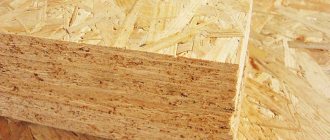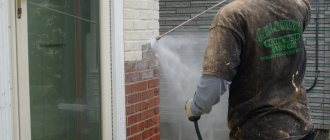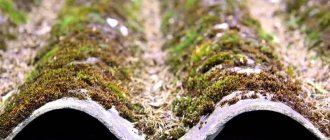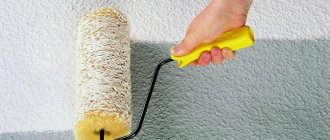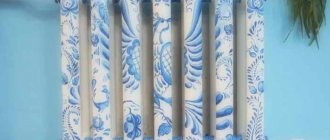Since ancient times, people have built working fireplaces in their dachas or country houses, which filled the rooms with warmth and made it possible to cook food. If such a structure is old enough and needs to be restored, then a logical question arises: how to paint the brick stove in the house.
Here we should start from two ideas: either the owners are pursuing an aesthetic goal, or safety is of primary importance to them. In most cases, you can do this work yourself; the main thing is to choose the right tools and paint materials.
Brickwork processing
Why paint?
There are several reasons for painting brick stoves:
- Aesthetic side: the stove in the house serves not only for heating and a comfortable stay in the house, but also to maintain its interior, creating a special comfort in the atmosphere of the home;
- The practical side: after painting the fireplace, the heat transfer into the house increases, the surface of the stove becomes smooth;
- Increased safety: treating the stove surface with various means prevents the appearance and growth of cracks in the brick.
Preparation for painting: important requirements
When carrying out work on painting the surface, it is worth considering that brick is a porous material. To completely dry and weather the wall, the house must stand for a long time in its original form.
If you paint the brickwork prematurely, you can ruin the texture of the freshly painted wall.
For external work
When choosing to paint an external brick wall, you should consider the following points:
- It is not advisable to paint fresh masonry. The surface must fully go through the stages of drying, weathering and leaching. This may take a year.
- Before painting, prepare the wall surface; it must be clean. To do this, remove salt stains, wash with soapy water and allow to dry thoroughly. Excess moisture will evaporate from the surface within a week.
- Painting brickwork creates a modern and trendy style for your home. Attention is diverted from small defects in the walls. You can choose a paint color that matches other buildings on the site.
Large and clearly visible imperfections are better to be filled or plastered. Although the brickwork should be rough with a surface without large cracks or chips, it is easier to paint this way, and the wall looks neater.
The surface should be carefully primed. Choose a deep penetration primer that creates a dense water-repellent film.
Brick, as a building material, is not entirely suitable for painting. This is due to its porous structure. In the future, removing paint from it and plastering the surface will be quite problematic. The only option is to repaint the wall a different color.
The surface must be clean before painting. All salt stains must be removed with a wire brush (never use acid!). Wash the wall with soapy water and leave to dry: the brickwork needs about a week for all the excess moisture to come out of the pores.
How to paint a brick stove?
There are several materials that can be used for painting:
- Enamel. It is characterized by good strength, resistance to moisture, excellent interaction with other materials, increased durability - it can withstand up to 200 cycles of sudden temperature changes. There is also a small drawback - the choice of enamels colors is very scarce.
- Oil paint for a brick stove. Among all the options, this is one of the best. The main advantages: a variety of colors, the ability to withstand temperatures up to 600°C, guaranteed protection of bricks from oxidation, increased resistance, durability - lasts up to 10 years of operation with the stove. Oil paint is easy to apply and does not require additional priming of the exterior. There are also disadvantages: not a very pleasant smell, the presence of toxic substances in the composition, longer drying compared to other options.
- Drying oil. Coating with natural drying oil cannot change the original color of the brick, only darken its shade.
- Heat-resistant varnish. Its main advantage is the ability to increase the technical characteristics of the strength of bricks. After applying the varnish, a transparent shiny layer remains on the surface. A special feature of using varnish is the ability to add dry gouache to obtain the desired color and shade.
Requirements for oven paint compositions
The paint must withstand high temperatures and not emit toxic substances.
An oven is a complex device in terms of operating conditions, so certain conditions are imposed on the choice of paint. The material must be resistant to high temperatures. The heating ranges of different parts of the furnace are different, which must also be taken into account. The iron part heats up more, so it needs a more heat-resistant composition.
Based on the degree of resistance to elevated temperatures, paints for brick stoves can be divided into fire-resistant, heat-resistant and heat-resistant. The former can withstand temperatures up to 1800°C. They are expensive and are almost never used in everyday life. Heat-resistant painting materials can withstand temperatures of 600°C – 1000°C. Used for painting iron parts in the stove. To paint the body, special heat-resistant paints are used that can withstand 200-400°C.
Also, the coloring composition must meet the following characteristics:
- Safety. When heated, no harmful substances should be released. For this reason, you should definitely familiarize yourself with the composition of the paint before covering a red brick stove with the mixture.
- Thermal conductivity. The composition should not interfere with heating the room and reduce the efficiency of the stove.
- Resistance to household chemicals. Must withstand routine care procedures.
- Elasticity. Cracks should not form during temperature fluctuations.
There are several types of paints and varnishes for the stove.
DIY painting materials
If there are any reasons why you cannot or do not want to buy special materials for painting the stove, you can start making them yourself.
- Chalk or lime solution. To prepare it, you only need water and lime, which can be purchased in large quantities at any hardware store. The difference between these solutions lies only in the duration of their drying: when applying the first layer of chalk, you must wait for it to dry completely, and layers of lime mortar can be applied immediately. To prepare the solution you will need 1 kg of lime or chalk and 1.5 liters of water. To achieve strength in the final result, table salt must be added to the solution - 300 g of salt per 2 kg of coloring solution. If there is no salt, you can use wood glue - 100 ml of glue per 10 liters of solution, but this paint will be yellowish. To avoid this, you can pour 20 ml of blue into the coloring mixture.
- You can also paint a brick stove using natural varnish. To prepare it, you will need chicken egg whites and milk in a one-to-one ratio, as well as dust from bricks that remains after laying the stove. To process one square meter of stove you need about a quarter liter of milk and 8 egg whites. To prepare this varnish, beaten egg whites and cow's milk are added to brick dust until a thick consistency is formed. The well-mixed solution is applied with a brush to the preheated oven surface. The result is a smooth red coating with increased temperature resistance and durability. To achieve a matte surface structure, you can cover it with drying oil on top. Natural varnish has its drawbacks: when it comes into contact with a painted surface, marks may remain. To prevent this from happening, you can apply an egg white solution on top. Also, during the heating process of the stove, the coating emits the smell of baked milk, which is a disadvantage for most people.
What should be the finish of a brick oven?
At first glance, it may seem that the main obstacle preventing you from painting the stove is the low heat resistance of water-based paint. But in fact, the requirements for painting materials are much broader:
- The paint and varnish coating must be firmly held on the surface of the plaster;
- The water-based mixture that is supposed to be used to paint the stove should not emit odors or fumes;
- The paint layer should not interfere with the “breathing” of the brick walls of the furnace or prevent the penetration of water vapor;
- Coatings based on water-based mixtures should not age, darken or turn yellow.
Of course, in addition to durability and vapor permeability, painting the stove solves the main problem - to make brick walls more attractive and prettier. Moreover, modern paints, regardless of the base used - water-based, latex, polyurethane or alkyd, have very rich and bright colors.
It is not necessary to try to paint the stove in the traditional white color; paintings using graphics or special techniques that visually mask the solid mass of the stove in the interior of the room are more interesting.
The main advantage of water-based and water-dispersed materials is the ability to use surfaces that do not require a primer for painting. In order to paint the stove, you do not need to dry the brick walls for a long time or use expensive primers.
Advice! If you are not a fan of Loft style design and prefer ordinary, more familiar interior options, then classic bricks or cement-sand plaster in a modern house will look archaic.
Often the stove occupies a significant part of the room, most often in the center or closer to the interior walls of the house. No matter how much you would like to put the stove, like a fireplace, in the corner of the room, you still have to touch the surface of the brick walls with your hands and clothes every day. Therefore, it is better to paint with paint that is resistant to abrasion than to suffer with cheap, but not always convenient, whitewash. In addition, the walls of the stove need to be painted, at least so that dust does not collect and the brick does not absorb odors and fumes from burning wood or briquettes.
Preparing the furnace surface for work
When painting a stove, the first thing you need to do is prepare its surface for painting. A stove with new masonry does not require any special operations, only cleaning from dust. If the stove is plastered, pay attention to the thickness of the plaster layer.
To clean the surface of the oven you will need the following equipment:
- Metal spatula to prepare the surface and also for puttying;
- Brush for removing remnants of previous finishing.
If the layer of plaster is more than one centimeter, the plaster requires dismantling - crumbling areas are removed, the surface is cleaned using a metal spatula, brush or sandpaper. All cracks and missing parts are covered with lime-clay or gypsum mortar.
After the solution has dried, wipe the surface with a damp cloth, wait for the water to dry and you can apply the coloring agent.
It is important to carefully read the instructions before using any coloring product from the store, because some types can only be applied to a preheated surface!
To ensure good interaction of paint with other substances, you can saturate the surface of the stove with a primer before painting it.
Cladding methods
If you don’t know what to paint the structure with, you can finish the existing fireplace using one of the methods presented below:
- Plaster and then apply water-based paint.
- Simply paint without pre-coating with anything.
- Coat the stove surface with a varnish that is resistant to high temperatures.
- Apply a pattern with a relief to the brickwork, and then secure it with a special varnish coating.
If you paint the fireplace as presented in the last version, it will significantly change its appearance, become more aesthetically pleasing and attractive, while the coating itself will not lose its original appearance for many years.
Using protective decorative varnish
How to paint a brick stove?
There are no particular difficulties in painting a brick stove, so anyone can do it, even if they have not done it before.
Painting, especially for a newly plastered stove, occurs only after all preparatory work has been followed and completed, otherwise it will not be effective and will have to be repeated after a short period of time.
For coloring you will need the following equipment:
- Container for coloring agent;
- The coloring solution itself;
- Convenient brush and roller.
Prepare a coloring solution and apply it in the required number of layers. It is recommended to apply the paint in two or three thin layers, using both a brush and a roller if possible. A brush can add texture to the outside of the fireplace, and a roller can distribute the paint evenly over the entire surface. If desired, patterns can be applied to the final layer of paint.
Examples:
Stove painted with lime mortar
Painting the stove with a special varnish
Stove painted with natural varnish and drying oil
Stove painted with enamel
Methods for painting a balcony wall
When deciding on the choice of paint and varnish material, you should understand the purpose of such treatment:
- protection of the base of the structure - a paint or varnish layer prevents cracks in the masonry and their growth;
- giving smoothness to the rough walls of the structure, while improving heat transfer;
- modern look, harmony with the surrounding environment.
You can paint a wall in one of two ways - leaving the brick texture unchanged or leveling the wall with a layer of plaster and then painting it. The first method can only be used if the brickwork does not have serious defects. The second method can be used if the wall needs serious repairs or the “brick” design does not correspond to the overall style of the interior.
Balcony with painted brick wall
This method is simpler, but to prevent the paint from crumbling and swelling over time, it requires careful preparation of the surface, which includes several steps:
- Surface cleaning;
- Seam alignment;
- Wall primer.
Painting a brick wall without plaster
The brickwork is cleaned of dust, dirt and mortar, and if the brick has already been painted, the previous layer of paint must also be cleaned off. If this is not done, repainting may pull the old paint and cause it to peel off the surface. The seams are cleaned with a stiff brush, and the voids identified during the cleaning process are filled with mortar.
This must be done with care so that the seams are filled evenly and they do not differ from the general background, and also trying not to stain the brick.
Now the wall needs to be primed - this will promote better adhesion of the paint to the brick. The choice of primer depends on what type of paint you will be using. How to beautifully paint the outside of a house using plaster photos?
Immediately before priming the wall, clean it again with a vacuum cleaner to remove dust. This way you can avoid the formation of small lumps that appear during the application of the primer and then clearly stand out under the paint layer.
Painting a brick wall on a loggia or balcony should begin only after the primer has dried. We recommend doing this with a brush, which allows you to better paint corners, small protrusions and grooves in seams. A paneled brush 6-8 cm wide is suitable - it fits freely into the grooves of the seams and evenly distributes the paint over the surface of the brick.
A roller or sprayer can be used if the balcony walls have a large area.
We invite you to familiarize yourself with the Foundation for a house on clay
If you decide to paint a brick wall on a balcony using this method, the whole process will take longer because it includes the following steps:
- Surface cleaning;
- Plastering;
- Putty;
- Primer.
Paint the brick white
The surface is cleaned of dust, dirt and loose formations, and a layer of plaster is applied to it. If the loggia is not heated in winter or the outer wall needs to be painted, prepare a cement-sand mortar. For closed heated balconies, it is permissible to plaster with gypsum mixtures without adding cement.
Using a layer of putty applied to the plaster, you can achieve a perfectly smooth surface, and this is especially true for the interior decoration of a loggia used as a living space. For external walls or unglazed balconies, you can skip the stage of puttying the walls, since under the influence of temperature changes and moisture, the putty will peel off and the walls will need to be repaired more often.
After drying, the wall can be primed and painted. It is better to paint with a roller or spray, after covering the windows and floor with plastic film.
conclusions
In currently popular interiors - country, chalet and shabby chic, the main highlight is the naturalness of various decorative elements and details. A classic Russian brick stove or fireplace fits especially well into them.
A brick stove is an excellent option for providing coziness and comfort in your home; it will give you the opportunity to watch the picturesque flames and provide warmth to your home. In order for the stove to look decent, it must be painted.
This can be done by choosing any method from the many provided. You can paint the stove with special paint from the store or prepare a composition for the coloring solution yourself. The main thing is that the paint is heat-resistant and durable.
The use of coloring agents for metal and with metallic substances in their composition is not recommended - they are not able to maintain their color and quality at high temperatures.
Types of professional materials
The range of paints and varnishes for stoves is presented by Russian and foreign manufacturers. You can find paint for any budget with any characteristics. The product can repaint the stove a different color or give it a darker or lighter shade.
Organosilicon compounds
This type of composition includes various mixtures created on the basis of organic resins. These can be paints, varnishes, enamels. Used for exterior finishing work and painting interior elements in the house. The choice of dye and its characteristics is determined by its purpose.
To cover the surface of stoves and fireplaces, heat-resistant silicone paints are used. When purchasing, it is important not to confuse the composition, since moderately heat-resistant solutions are produced with a similar name. They cannot withstand temperatures above +100°C.
The positive features of such mixtures include:
- Good adhesion. The paint is easy to apply to any texture.
- High strength.
- The formed shell protects the oven well from moisture.
- Long service life.
- Good heat resistance and elasticity. The paint can withstand about 250 cooling and heating cycles without losing its properties.
The coloring matter has one significant drawback - the limited color palette. This is due to the chemical composition and scope of application.
To apply enamels and paints, use a roller, brush or spray gun.
Heat-resistant acrylic paints
The group of heat-resistant acrylic paints includes water-based or hydrocarbon-based materials made from acrylates. They are able to withstand temperatures up to 400°C depending on the composition. In domestic conditions, water-dispersion paints are most often used, although water-based substances can be used.
Alkyd emulsions
The name of the substance “alkyd” consists of two definitions - alcohol and acid. Emulsion paint contains an alkyd varnish, a coloring agent and a solvent, which is most often white spirit. Also, different types of paints may contain marble and granite dust, as well as additives against fungi, mold, and fire.
Alkyd emulsion is used to coat the body of a stove or fireplace. The temperature on the surface should not exceed 100°C - this is the main disadvantage of such products. At the same time, the color palette is very diverse. It is also important to note the low elasticity of the solution. It does not withstand temperature expansion, which is why after a year small cracks form on the painted surface of the stove.
Heat resistance is increased by adding aluminum powder to the water-based solution. But such compositions are not suitable for painting stoves and fireplaces.
